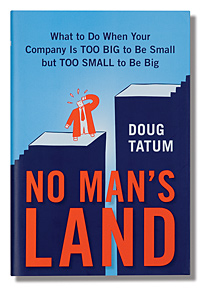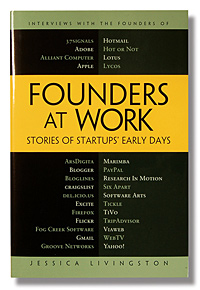Best Business Books: The Entrepreneurs
Startup Memories
(originally published by Booz & Company) Kim Lavine
Kim Lavine
Mommy Millionaire: How I Turned My Kitchen Table Idea into a Million Dollars, and How You Can, Too!
(St. Martin’s Press, 2007)
Jessica Livingston
Founders at Work: Stories of Startups’ Early Days
(Apress, 2007)
David Silverman
Typo: The Last American Typesetter, or How I Made and Lost 4 Million Dollars
(Soft Skull Press, 2007)
Doug Tatum
No Man’s Land: What to Do When Your Company Is Too Big to Be Small but Too Small to Be Big
(Portfolio, 2007)
No ventures better reveal the dynamic nature of economic activity or the human drama of business than startups. This is true whether the startup is a new stand-alone venture, a subsidiary spin-off from a large corporation, or the creation of a lone entrepreneur starting from scratch. Startups flourish where visionary entrepreneurs see ways to satisfy needs with new products, services, and technologies; they act as beacons of opportunity that signal how young niches can grow into major industries. Startups can also produce dramatic stories of personal success and failure that teach, inspire, and chasten those who are brave enough to lead a startup themselves.
Whereas business titles aimed at established managers in established companies trade in big ideas, such as disruptive innovation, it is the startup books that focus on the basic management skills necessary to launch and grow a successful new enterprise. Above all, the best entrepreneurial titles about startups deal with learning. They show how individuals must develop both inside and out, acquiring self-awareness and managerial mastery while simultaneously learning what exactly their market values.
New ventures generally spring from the passion of an individual or a group of individuals. And even if the leader has some business chops, participants in those ventures are often novices in the market they want to serve or in using the new model they aim to pioneer. As a result, every startup offers a distinctly different saga of how visionaries become managers and how viable and self-sustaining enterprises emerge from promising opportunities. Today startups can launch more quickly, with less early capital, and grow faster than ever before. And as a result, the greatest stumbling block may be the experience and talent of the founders.
Whether you are a fledgling entrepreneur, a division manager, a project leader, or the head of a multinational, the lesson from all these books is this: Become skilled, wise, and professional as early as possible. The prospects for all startups today, whether de novo or repotted from corporate soil, are increasingly calibrated to the founders’ personal strengths and weaknesses.
Indeed, all managers reckoning with the entrepreneurial journey must learn to exploit their strengths, compensate for their weaknesses, and above all, see how their personal traits bear upon the growth of their business. They must also be willing to swap out, trade up, or rapidly adjust their capabilities. The shelf life of any great idea or market niche continues to shrink, making it ever more important for entrepreneurs to use every venture as an experiment in their own managerial growth. To paraphrase Gandhi, “You must be the startup you want to see in the world.”
Mommy Millionaire: How I Turned My Kitchen Table Idea into a Million Dollars and How You Can, Too! written by mom-turned-CEO Kim Lavine, breathes new life into what has become an entrepreneurial archetype — that of an inspired person inventing a colorful new artifact (in this case, a comforting neck pillow filled with corn that can be warmed), and then painfully acquiring the experience to build a successful venture around this product.
Lavine’s honest account tallies the rookie stumbles she made and the fouls she had to overcome, but her entrepreneurial injuries are mere cuts and scrapes compared with the fateful blows suffered by David Silverman. In his poignant book, Typo: The Last American Typesetter, or How I Made and Lost 4 Million Dollars, he recounts his naive and unsuccessful effort to stem the migration of the domestic typesetting industry to lands of cheap labor.
These sagas are rounded out by the collection of stories in Founders at Work: Stories of Startups’ Early Days, by Jessica Livingston, an excellent collection of interviews with successful tech startup founders. This entrepreneurial Scheherazade shares numerous tales of how small, passionate discoveries can produce huge expectations, tease great fortunes, harm friendships, and — with the right measure of experience and capital — grow into big business.
In No Man’s Land: What to Do When Your Company Is Too Big to Be Small but Too Small to Be Big, Doug Tatum explores the perilous zone a company enters when it has outgrown the habits and practices that fueled its early growth, yet is not mature enough to cope with the next phase of development.
Business Is Personal
Kim Lavine’s memoir-cum-business-primer breaks new ground in the crowded field of startup sagas. By seamlessly blending the epiphanies that she gained through launching a business with practical lessons, Lavine has packaged a core set of new-venture tenets into something fresh and relevant. Lavine frames her tale with the message that “the virtue of all success is victory over all one’s personal shortcomings.”
Her story begins with a small “eureka” moment when she realizes that the cute, corn-filled pillows (which can be warmed in a microwave) she created as gifts for her children’s teachers might have commercial promise. Naming them “Wuvits,” and forming a kitchen-table venture to brand and sell them, Lavine gradually sees that she can build a real business from these seeds. This small opportunity gains urgency when her husband loses his job.
Like many determined entrepreneurs, Lavine encounters a humbling string of mistakes, failures, cons, charlatans, and small victories in the course of coaxing her enterprise to take baby steps. Constantly disappointed by sales reps with more sizzle than steak, lawyers who patronize her, employees who fail to get on board, and a manufacturer that produces tens of thousands more units than are needed, Lavine gradually develops the wisdom and self-confidence to learn from her mistakes — and in the process, she perseveres through the experience to form healthy relationships and institutionalize the right management steps to move forward. Her growth from an undercapitalized trinket company run by a timid woman to a sufficiently capitalized company with a vivid (and protected) brand selling through multiple channels, sourcing globally, and supported by industry veterans, is both instructional and inspirational.
Lavine’s book is worth reading to remember what endures in the sea of change. For one thing, she presents fresh insights about gender and enterprise. Unlike most books written by or about women in business, Lavine reckons with sexual politics and differences without trivializing them or overplaying their significance. When she starts the company, Lavine finds herself apologizing for (or even hiding) her children when business meetings conflict with her parenting time. Yet after a sobering incident in which she briefly leaves her sleeping toddler in the car while meeting with a lawyer, Lavine resolves never to apologize for this again. “If there wasn’t room for my kids in this new journey I was embarking upon, where I was the president of a company that I founded and funded, I wasn’t going,” she writes.
Her epiphany reminds professionals at every level that although workplaces will always tilt sharply to one end of the work–family balance, there is no setting entirely free from the necessary demands of family, and the increasingly proper response is to acknowledge rather than scoff at them.
Mommy Millionaire, for all its timeless lessons, has a high degree of currency right now, as a reminder that for every single venture-backed, high-potential media darling, there are literally thousands of personal, homespun, low-tech enterprises like Lavine’s. For her and for countless others, the role of new technology is not to produce one high-flying media star like Google, but to lower the barriers to entry for other small companies like Lavine’s Green Daisy Inc. “I didn’t need to go out and create cold fusion or launch a billion-dollar technology IPO of a stock to be traded publicly to make a million dollars,” she says. “All I had to do was sell comfort and warmth to at least a very small percentage of 300 million tired and cold bodies who just wanted to come home from the daily grind, sit on the couch with their kids, and hold a warmed Wuvit to their chest or their necks while they watched TV.” Her ability to fuel her growth by tapping into new television channels such as QVC shows how new methods of distribution can boost the most low tech of products. Her chapter on the difficult but ultimately successful quest to break into the popular channel sparkles.
 Slow Learner
Slow Learner
A story of hard-earned success can teach much, but an honest and noble tale of failure is often a far more potent fable. David Silverman’s Typo is an honest, elegiac tale of an unsuccessful venture to revive the American typesetting industry. Silverman’s painfully personal story of his company’s demise highlights many of the often insurmountable challenges that business leaders must face at a personal, managerial, and strategic level. Unfortunately for him, he must learn too much on the job. The nuances of managing people, coupled with the natural conflict between capitalism and humanism, and, in his case, the business consequences of a young owner’s naivete, prove to be an overwhelming curriculum. “Trying to cram a literal decade of change into three months” is too great a goal.
Like many individuals whose technical expertise is essential to the success of the venture and yet is entirely insufficient for tackling the broader management challenges, Silverman slowly discovers that implementing better information technology and more efficient work processes is as effective as prescribing an aspirin for a patient with a brain tumor. He and his mentor purchase Clarinda, an Iowa-based typesetting company that is threatened by the exodus of this work to low-wage countries. They hope to use new technology and training, along with economies of scale from rolling up competitors, to turn the company around.
Yet their ambitions are thwarted by a multitude of obstacles. Clients demand unreasonable cost reductions, while they are simultaneously sending work overseas. Within the company, a cast of stubborn, small-minded workers continually thwart Silverman’s attempts to change antiquated, costly, and, in some cases, completely unnecessary work practices. While Silverman fails to make changes in Iowa, shifting global economic conditions raise the stakes. Competitors in India and the Philippines are willing to do the work at one-thirtieth of the labor costs. And publishers encourage the trend by sending these overseas companies the work.
Ultimately, Silverman learns too slowly. Financial literacy, managerial know-how, dispassionate human resources skills, and industry big-picture wisdom do come to him eventually. He introduces clever plans to work more effectively, yet fails to adopt a rational and fine-tuned picture of total company costs until too late in the game. The stakes are high. Not only does he lose the business, but he also loses his partner, and many of his youthful illusions to boot.
In the end, Silverman must reckon with several painful truths about his personal ability to help others, as well as the greater goal of designing companies with a soul. The son of an IBM man, Silverman brought a benevolent view of capitalism to his venture, one informed by growing up in a home where his father had benefits, job security, and a retirement plan.
“Capitalism is about making money,” writes Silverman wistfully. “Benevolence is a feature of companies that have enough excess profits to afford it. IBM survives today because the old IBM employee recreation center with the Olympic pool and discount hamburgers that my father valued so much has long been abandoned and become overgrown with weeds.”
Because David Silverman does not flinch from sharing the most painful and revealing lessons of his journey, I name Typo my top pick among this year’s titles.
 Wisdom Doesn’t Scale
Wisdom Doesn’t Scale
Doug Tatum’s No Man’s Land adds a nice bit of perspective to these two sagas. Like several other vital books that chart how companies grow, such as Ichak Adizes’s Managing Corporate Lifecycles: Founding Principles in the Management of the Arts (Prentice Hall, 1999) and Eric G. Flamholtz’s Growing Pains: How to Make the Transition from an Entrepreneurship to a Professionally Managed Firm (Jossey-Bass, 2000), Tatum’s helps entrepreneurs assess how well suited they are to take their venture to the next level.
Tatum identifies a specific growth period for startups: No Man’s Land, a form of adolescence when the founders face key decisions dealing with “what to do when your company is too big to be small but too small to be big.” Such a transition has always been part of what Adizes defined as the corporate life cycle — a well-defined process of growth with identifiable milestones as a venture matures. Yet No Man’s Land does a good job of making this message current by identifying ways that the impact of technology on accelerating growth is affecting how startup founders should consider the questions they ask when analyzing their venture’s potential. Tatum writes in a direct and engaging manner that focuses this material more clearly on his readership.
He argues that this adolescent stage kicks in after the full-time head count reaches roughly 20 employees. This is a threshold that forces a growing company to step back and reexamine how it can continue to satisfy the core value it offers as it becomes a fully formed venture. Such a transition is never easy. Often the very skills and passions that accounted for early success (such as stubborn focus and unyielding charismatic leadership) can be poison to sustained growth. Tatum says that companies must shift from what is often intuitive and undisciplined leadership by the founder to a more systematic way of delivering on the core promises it makes to its customers. The accepted way of working, which in most startups entails hustle, grueling hours, and improvisation, must morph into a more systematic, sustainable, and commonly understood way of acting.
Only by defining values and practices for itself can a business become scalable, Tatum argues. Often this transition requires a new set of leaders, people with experience at large companies. And it always requires a different financial structure — one geared for growth and stability rather than survival. He illustrates this point with nice insights: “Most entrepreneurs start companies because they want to work for themselves. As their companies grow, entrepreneurs come to realize that they are responsible for a whole new constituency: their employees. When entrepreneurs make it through No Man’s Land, however, they might also become responsible for pleasing a third constituency, their equity partners.”
This smart book communicates its key ideas vividly with great company stories and evocative writing. Tatum explains, for example, that a growing company must evolve like a children’s soccer team. It must move from the stage where everyone is chasing the ball to a team where “everybody plays rationally and plays a specific position.”
 From Pride to Maturity
From Pride to Maturity
The model introduced by Tatum has broad value for new ventures, and it is reinforced by the variety of the individual narratives in Founders at Work, by Jessica Livingston. This compilation of interviews with 32 high-tech company founders (or early employees) provides insight and color into the formation of companies such as PayPal, Yahoo, Craigslist, and Apple.
In her introduction, Livingston explains that the goal of her interviews “was to establish a fund of experience that everyone can learn from.” The random tales that she has gathered — of fits and starts, of individuals focusing on following their coding bliss, and of scoring big wins by focusing on small but achievable goals — all resonate powerfully.
There are numerous gems of wisdom sprinkled throughout the book. Ray Ozzie, founder of two startups and now the chief software architect at Microsoft, reminds zealots that ventures must eventually thrill customers: “I’ve never taken the perspective of ‘build a cool piece of technology and see where it goes,’” says the builder of some of the coolest pieces of technology (such as Lotus Notes). “It’s more or less been based on an intuition about a hole in the market — or more accurately, a future hole in the market.”
His point is echoed by Blogger cofounder Evan Williams, who recognizes that blogging will dramatically change the Web because it represents one of the first “native forms” for the new medium. Williams’s tale is notable for its candor about the personal toll that Blogger, which emerged from blogging startup Pyra Labs (and was the first acquisition by Google), took on his colleagues. “People live and breathe [their work] and become friends, date, and merge their lives together. And then, if things go bad, it’s bad in ways that are much more devastating than your work going badly.”
One important theme of the book is the way in which the entrepreneurs have adapted the business models of their companies to their customers’ needs. “People think startups grow out of some brilliant initial idea like a plant from a seed,” writes Livingston. “But almost all the founders I interviewed changed their ideas as they developed them. PayPal, which started out writing encryption software, is today a dominant online transaction management service. Excite started out as a database search company, and Flickr (now the leading Web site for sharing images) grew out of an online game.” Each of these companies eventually emerged as a major force on the Web. Their success can be traced to the ability of the founding team to stay in the game long enough to allow their unique customer offering to gel. The founders learned to temper their pride and passion over their new creation with a mature patience and willingness to adapt. This is what enabled these ventures to develop into enterprises capable of sustaining new growth.
Small Enterprises, Big Lessons
Although this collection of startup memoirs is written by small business entrepreneurs, the lessons are big and broadly applicable to all new ventures. Wherever startups begin, the experiences are always personal; they are driven by passionate individuals, marred by painful fits and starts, and inspired by quirky happenstance or ambitious global goals. Few successful new ventures become the company that was originally conceived. Startups always respond to change — and as a result there are few that are not changed as they mature.
The path to sustainability (as in self-funding growth) must be discovered through experience rather than plotted on a map. And the ability to become a viable and ultimately thriving venture rests on the experience, network, and wisdom of the particular founder and founding team. More than any single product or service, their long-term success depends entirely on the quality and capability of the company they have created. ![]()
Author profile:
Tom Ehrenfeld (tomehrenfeld@comcast.net) is a former writer and editor at Harvard Business Review and Inc. magazine. His work has also appeared in Newsweek, the New York Times, Boston magazine, and Parenting magazine. Based in Cambridge, Mass., he is the author of The Startup Garden: How Growing a Business Grows You (McGraw-Hill, 2001).



